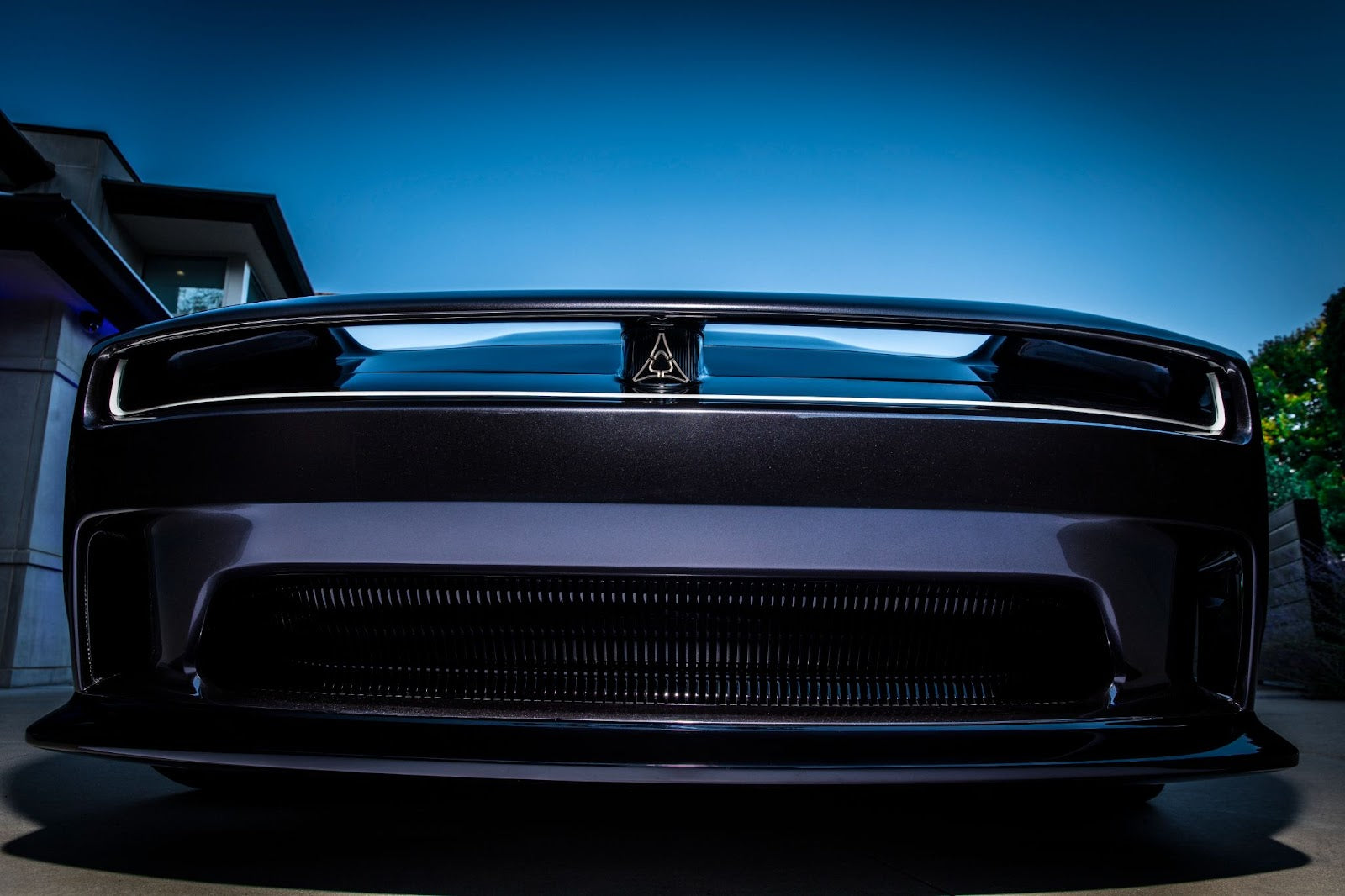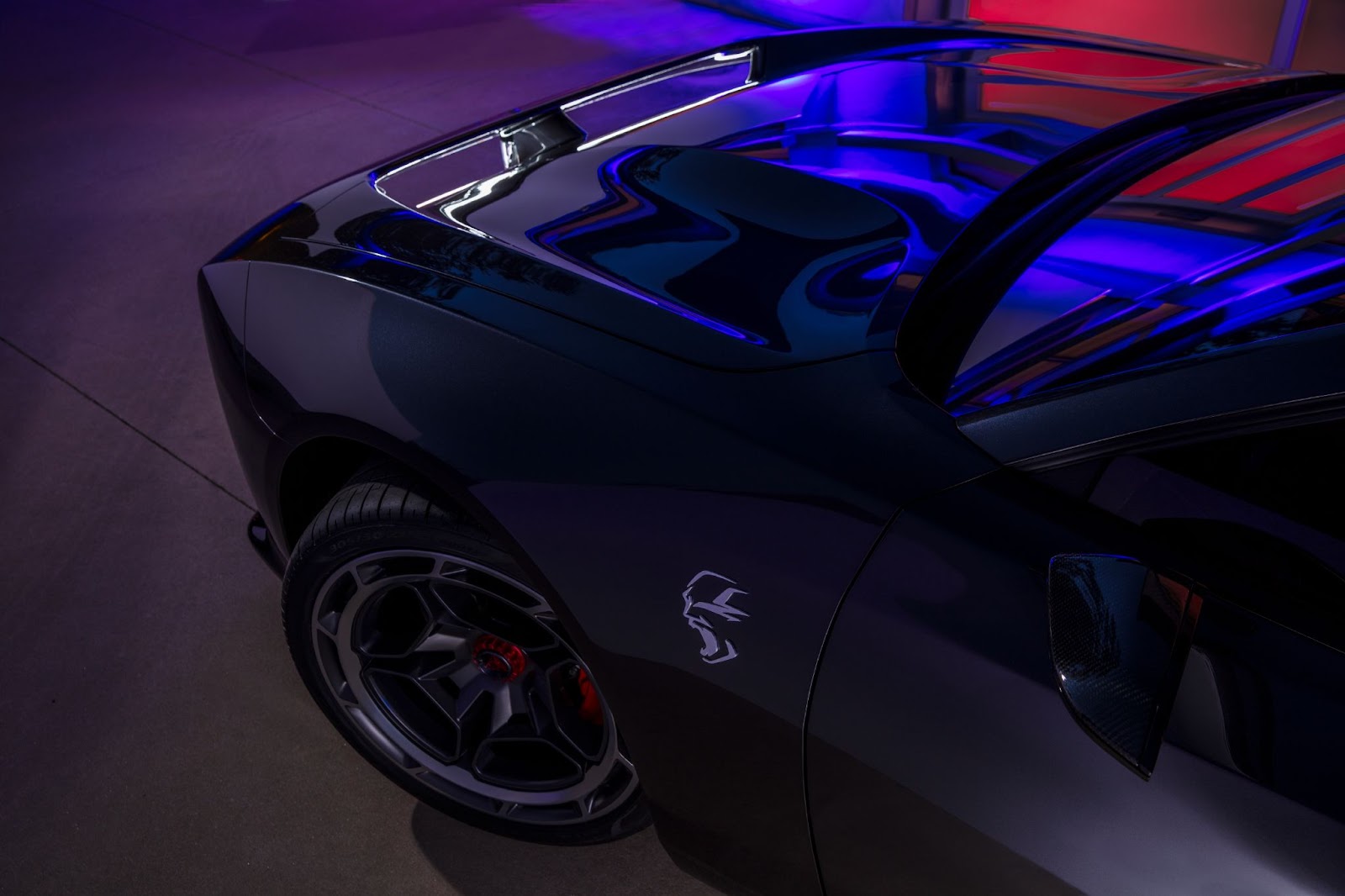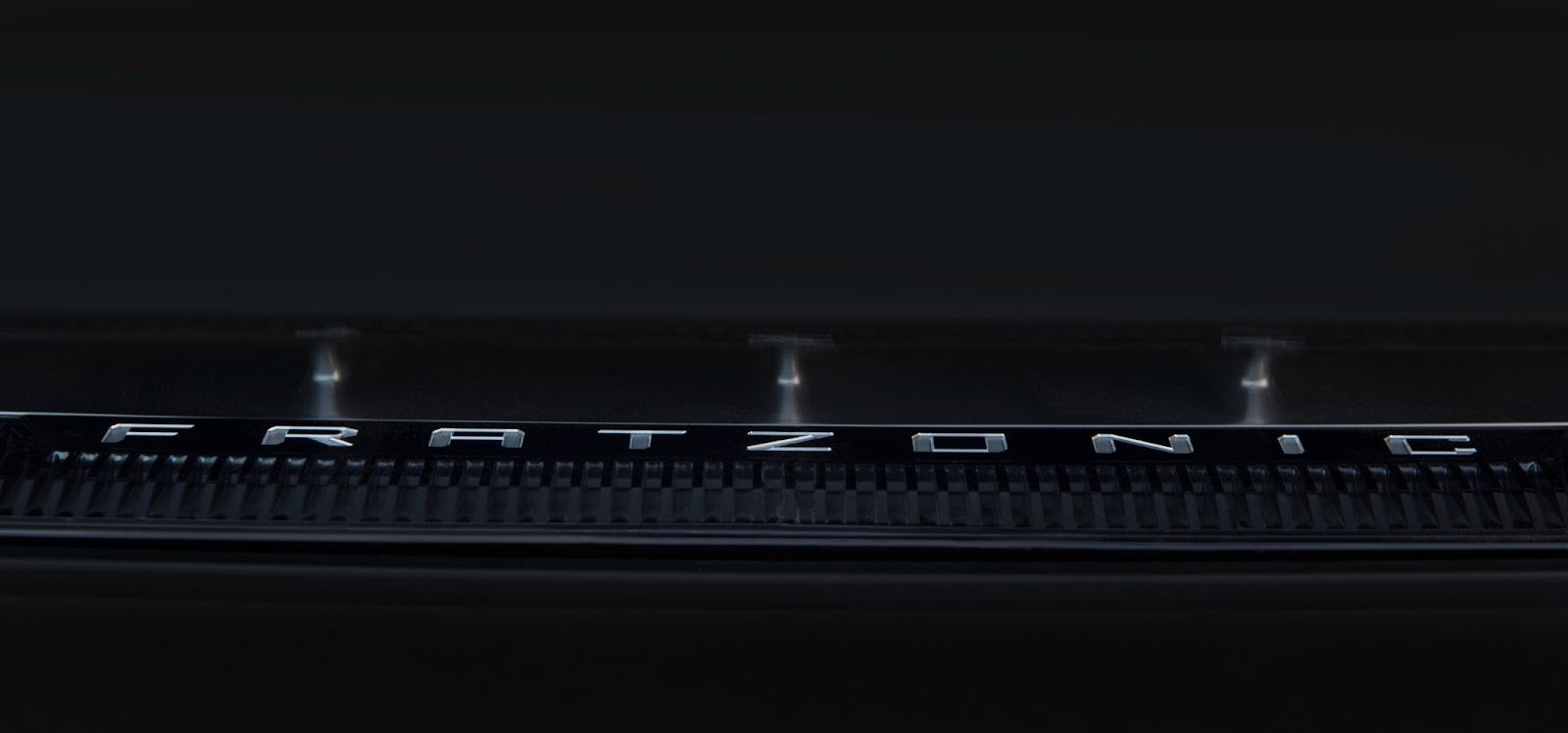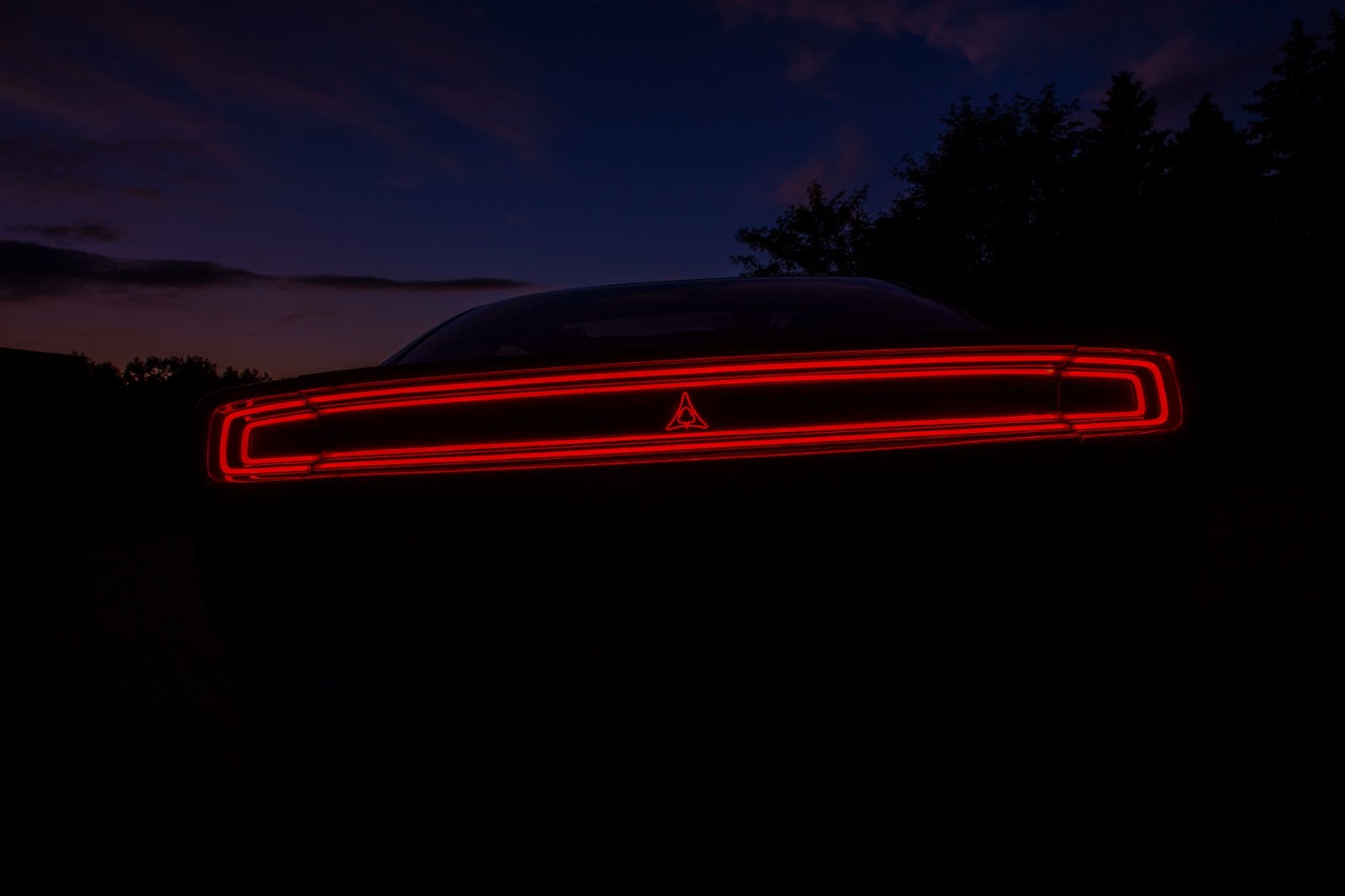 Dodge division of Stellantis North America
Dodge division of Stellantis North America
Dodge showed the Charger Daytona SRT Concept at SEMA with a number of innovations and outlines the performance levels of the purely electrically powered muscle car. Is it an electric car? No! Dodge doesn't want to sell electric cars; Dodge wants to sell the first American E-Muscle.
The brand boss Tim Kuniskis spoke about the concept saying that Dodge will not sell electric cars, but American electric muscles. And this hits the core of the brand and, thus, precisely what Dodge fans want to hear and see. The concept study presented at SEMA shows clearly that the performance brand is also entirely behind the promise.
It goes by the model name Charger Daytona SRT Concept, which leads us to the first unusual feature: the show car arrives as a two-door, although the last generation of the Charger was a four-door sedan. So is there a change in the body concept here?
The Design
 Dodge division of Stellantis North America
Dodge division of Stellantis North America
Dodge’s highly accomplished designers were clearly trying to combine the classic muscle car proportions with modern electric car aesthetics. The three-box layout is retained and continues to combine a high shoulder line with a narrow window band.
However, you shouldn’t be looking for chrome on the Charger Daytona SRT Concept; otherwise, you could be disappointed. As with many other e-cars, the light signature at the front and rear gives the study a certain brand identity.
There are narrow LED light strips designed as a continuous frame, with an illuminated logo at their center. This is a reinterpretation of the Fratzog logo used by Dodge in the 1960s and 1970s.
The design allows Dodge to use an aerodynamic trick on the Daytona SRT Concept. The e-musclecomes with the R-wing in the upper area of the front bumper, where the front hood is typically attached. This front wing ensures that the typical Dodge silhouette can be maintained but that’s not the only reason for it.
 Dodge division of Stellantis North America
Dodge division of Stellantis North America
The R-wing achieves greater aerodynamic efficiency by channeling the air in the front area and directing it over the car. At the same time, the wing is intended to pay homage to the original Dodge Charger Daytona, which also wore a powerful wing - albeit on the rear. The air intake above the front spoiler lip, which directs the airflow directly toward the rear diffuser, also fulfills aerodynamic tasks.
Basically, the design is one thing above all - no frills. The headlights are hidden under the R-wing, the door handles are just as flush with the body as the aprons, and the only graphic accent is the new Banshee logo on the front fenders.
The 21-inch wheels of the first version featured a diamond-cut surface and center lock, revealing the red six-piston calipers of the Brembo stoppers. The SEMA version of the Charger Daytona SRT Concept features significantly smaller 18-inch carbon fiber rims,
The Interior
 Dodge division of Stellantis North America
Dodge division of Stellantis North America
The interior designers have consistently aligned the dashboard to the driver's seat. The central 12.3-inch touchscreen has a ten-degree left slant and is complemented by a 16-inch instrument display. A head-up display provides further information.
The cockpit presents a combination of visible carbon - for example, on the floor and back of the sports seats and in the form of the door sills - together with violet leather, which in turn has blue and silver accent stitching. The ambient lighting, which extends from the instrument panel to the doors and center console, gives Dodge a three-dimensional effect.
We Americans simply can't resist gimmicks, and Dodge knows how to use that very well. The start button is hidden under a bright red flap that has to be folded up – like on a jet fighter. In front of it sits the pistol-shaped automatic selector lever.
The steering wheel is flattened at the top and bottom, with the SRT logo illuminated in red at the center. It carries capacitive touch controls, as well as the selector buttons for the four driving modes (Auto, Sport, Track, Drag) and the Powershot button (see below).
The two rear seats can be folded down, which maximizes storage space - let no one say that such an electric muscle car can't also be practical. Oh yes: there is also a panoramic glass roof.
The Power
 Dodge division of Stellantis North America
Dodge division of Stellantis North America
Dodge uses the SEMA in Las Vegas to provide the first concrete information on the powertrain. In its production version, the electric Daytona will use two different architectures. The basis is a 400-volt system for which the manufacturer provides two power levels based on the kW power value.
In addition, there are two electric tuning kits offered via the factory tuning program "Direct Connection" - making a total of six power levels. It starts with 340 kW (462 hp), which can be boosted to 370 kW (503 hp) or 400 kW (544 hp) using the E-Stage kit. The 440 kW version (598 hp) can be upgraded to 470 kW (639 hp) or 500 kW (680 hp) for a surcharge.
That doesn't sound bad, but it's also not powerful enough for a brand whose most powerful series combustion engine currently delivers 818 hp and a maximum of 959 Newton meters. That’s why the Daytona series, in its particularly powerful variants with the additional designation SRT Banshee, will use an 800-volt architecture.
So far, Dodge has kept the technical data to be expected. But it is clear that there will also be a base value and two tuning levels. Regardless of whether the architecture is 400 or 800 volts: the additional power is unleashed via a crystal key that is inserted into the dashboard and that is just too cool.
The Technology
 Dodge division of Stellantis North America
Dodge division of Stellantis North America
We still don't know 100% whether Dodge will actually use the obvious chassis solution of its parent company Stellantis for the production car. The STLA (Stellantis Architecture) platforms are being developed across brands, all of which are intended for electric and hybrid applications (of course, also with a plug-in design).
The STLA-Large platform for the middle and upper middle class is readily available for Dodge and, therefore, an option for the brand's muscle cars. It is the first representative of the new architecture generation to be ready for use as early as 2023. It has also been confirmed that the concept study will be available with an all-wheel drive.
There is complete silence concerning the battery. So that the battery is not drained of its electrical energy too quickly because of the values mentioned, it should have a specific minimum size. Here, the platform mentioned offers optimal conditions because it has space for battery packs with a capacity of 101 to 118-kilowatt hours.
Depending on the derivative, these figures should be enough for a range of up to 500 miles. Since muscle car drivers are not exactly known as gas pedal strokers, this should not be a realistic everyday value for Dodge's new electric cars.
 Dodge division of Stellantis North America
Dodge division of Stellantis North America
Dodge is more specific about some technical gimmicks that characterize the Daytona SRT Concept and are intended to make it easier for muscle car fans to switch to an electric car.
For example, the E-Rupt transmission: An electromechanical circuit simulates shift points and the associated jolts that should throw the shoulders into the seat backs."At the push of a button, more power can be released for overtaking for a short time - the manufacturer calls this the "PowerShot function".
In addition, there is the patented "Fratzonic chamber exhaust": In the rear of the Daytona, there is an amplifier and a kind of resonance body, which together are supposed to produce engine noise. And not just as an alibi: the electric car is said to roar at up to 126 decibels in the loudest of the stored sound profiles.
The Price
It will be interesting to see which price tags Dodge will give its new electric muscle cars. For example, the Challenger currently starts at $30,825. With its standard V8, the 5.7-liter Hemi, the coupe starts at $39,075. In any case, the new EVs should settle above these sums; it will probably start somewhere between $40,000 and $50,000.
The particularly strong variants should saddle up in this respect as well. They already do: The 727 hp Hellcat version costs at least $69,620, and the top model SRT Super Stock with 818 hp starts at $87,530. Similar tariffs are therefore also conceivable for the new e-muscle cars.
CONCLUSION
 Dodge division of Stellantis North America
Dodge division of Stellantis North America
As a muscle car brand with a typical American character, Dodge had found the perfect niche for itself within the FCA group and naturally wants to retain this status under the Stellantis group. But CEO Carlos Tavares demands modern technical solutions, which is why the thick supercharged V8 will have had its day in the not-too-distant future.
From 2024, the brand will completely revise and offer purely electric muscle cars. Technically and visually, these are likely to be largely based on the present Daytona SRT Concept study. However, it remains to be seen whether every gimmick will make it into the series
The question is whether the production version of the electric muscle car will also bear the Daytona nickname. Recently there has been speculation that the traditional name 'Cuda could return. Dodge had previously protected the abbreviation derived from "Barracuda". Both names were used in the 1960s and 1970s by the then Dodge sister brand Plymouth for what are now legendary muscle cars.
All muscle cars need proper protection, and the E-muscle is no different. For all your protection equipment needs, we recommend Coverking. They are the best in the business and always know what they are doing. The company digitally scans each and every vehicle available on the market with the latest technology.
The ability to scan allows them to create the best custom-fitting equipment possible as soon as a new model is released. So, you can be sure that they will be the first to carry protective equipment for this new Dodge Charger as soon as it comes out.
Coverking is also the official protective equipment partner of most automotive manufacturers. Check out their catalog and find out what they can do for you and your vehicle.
Resources
- https://www.motortrend.com/news/2024-dodge-charger-daytona-srt-electric-muscle-car/
- https://www.topgear.com/car-news/electric/dodge-charger-daytona-srt-ev-will-be-available-nine-power-outputs
- https://www.caranddriver.com/news/a40921430/dodge-charger-daytona-srt-concept-ev/
- https://insideevs.com/news/619537/dodge-charger-daytona-srt-concept-gets-nine-power-outputs-for-sema/
- https://www.cars.com/articles/dodge-charger-daytona-srt-concept-up-close-video-456923/
- https://www.autoblog.com/2022/10/12/dodge-charger-daytona-srt-ev-concept-variant-sema/
- https://www.dodgegarage.com/news/article/press-room/2022/08/performance-made-us-do-it-dodge-charger-daytona-srt-concept-previews-brands-electrified-future.html
- https://www.media.stellantis.com/em-en/dodge/video/introducing-the-dodge-charger-daytona-srt-concept
- https://www.forbes.com/sites/samabuelsamid/2022/11/01/dodge-charger-daytona-srt-e-muscle-car-goes-to-sema-in-stryker-red/?sh=3be9a0545dca
- https://www.carscoops.com/2022/09/dodge-charger-daytona-srt-ev-concept-leaves-door-open-to-show-off-16-inch-digital-gauge-cluster/
- https://www.foxnews.com/auto/dodge-charger-srt-daytona-hot-rod-future
Tankut Basar
Tankut Basar is an ARA (American Rally Assoc.) Racing Driver and an FIA Bronze Category License Holder. His passion for driving began with karting like most racers. He started racing internationally at the age of 22. Tankut loves everything car-related and will keep enjoying the drive until the end.



